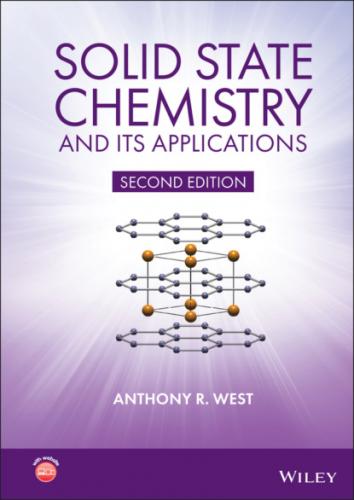1.15.3.3 Location of tetrahedral and octahedral sites in an fcc unit cell; bond length calculations
We have seen how T+, T– and O sites occur between pairs of cp layers, Fig. 1.23, and how fcc and ccp structures are often equivalent, Fig. 1.20. We can now see where the T+, T– and O sites are located within an fcc unit cell that has anions, X, at corners and face centres (A, B, C, and D), Fig. 1.24. The octahedral sites are easiest to locate; they are at edge‐centre 1, 2, 3 and body‐centre 4 positions. If the unit cell has length a, the M–X distance for octahedral sites is a/2.
In order to see the T+, T– sites clearly, it is convenient to divide the unit cell into eight minicubes by bisecting each cell edge (dashed lines). These minicubes contain anions at only four of the eight corners; in the middle of each minicube is a tetrahedral site, either T+ or T–. There are two orientations for the minicubes, and therefore for the T sites, as shown in Fig. 1.25; relative to the parent unit cell, Fig. 1.24, the T– tetrahedra have their apices pointing in the [] direction and the T+ sites in the [111] direction.
At this point, we note that it is exceptionally useful to be able to regard a tetrahedral site as occupying the centre of a cube with alternate corners absent, Fig. 1.25(a) and (b). For such an arrangement, it is easy to calculate bond lengths and bond angles (c) and to demonstrate the various symmetry elements associated with a tetrahedron. Thus, for the minicube of edge dimension a/2,
Figure 1.24 Available cation sites, 1–12, in an fcc anion array.
Twofold rotation axes and fourfold inversion axes run parallel to minicube edges but pass through pairs of opposite faces; there are three of these in total (see also Fig. 1.7c); mirror planes occur parallel to the set of lattice planes with indices {110}, and there are six of these in total [as in Fig. 1.9(c)]; threefold axes run parallel to <111> directions, four in total, Fig. 1.9(a); further details are in Appendix C.
1.15.3.4 Description of crystal structures; fractional atomic coordinates
In order to describe crystal structures, it is necessary to specify (a) the unit cell type, (b) its dimensions and (c) the fractional coordinates of the atoms in the unit cell. As described earlier, an fcc unit cell containing anions at corner and face centre positions has, effectively, four anions in the unit cell, one at a corner and three at face centres. The fractional coordinates of the four anions A–D in the unit cell, Fig. 1.24, are
Figure 1.25 (a, b) Tetrahedral sites T+, T– and their relation to a cube. (c) Bond length calculations and some symmetries of a tetrahedron.
Only one corner, at 000, is included since the other seven, e.g. at 100, 010, etc., are equivalent and can be regarded as the corner atoms of adjacent cells. The alternative would be to list all eight corner atoms, with the qualification that only 1/8 of each belonged to the unit cell in question. This would be equivalent to, but much more cumbersome than, regarding one corner only as specifically belonging, completely, to our unit cell. Likewise, for each pair of opposite faces, e.g. ½½0 and ½½1, it is most convenient to regard ½½0 as belonging completely to our unit cell; ½½1 then becomes the bottom face centre in the cell above.
The various cation positions in Fig. 1.24 have the following coordinates:
Note that there are four of each type of cation site, O, T+, T–, in the unit cell, together with four anions. When different sites are fully or partially occupied by the cations, different structures are generated, as indicated in Table 1.4 and discussed later.
1.15.4 Covalent network structures
Materials such as diamond and silicon carbide, which have very strong, directional, covalent bonds, can also be described as cp structures or eutactic structures; many have the same structures as ionic compounds. Thus, one polymorph of SiC has the wurtzite structure and it is immaterial whether Si or C is regarded as the packing atom since the net result, a 3D framework of corner‐sharing tetrahedra, is the same. Diamond can be regarded as a sphalerite structure in which half of the C atoms form a ccp array and the other half occupy T+ sites, but again the two types of atom are equivalent. Classification of diamond as a eutactic structure is useful since in diamond all atoms are of the same size and it is unrealistic to distinguish between packing atoms and interstitial atoms.
Many structures have mixed ionic–covalent bonding, e.g. ZnS and CrCl3; one advantage of describing them in terms of cp is that this can be done, if necessary, without reference to the type of bonding that is present.
1.15.5 Molecular structures
Since cp structures provide an efficient means of packing atoms, many molecular compounds crystallise as cp structures even though the bonding forces between adjacent molecules are weak van der Waals forces. If the molecules are roughly spherical or become spherical because they can rotate or occupy different orientations at random, then simple hcp or ccp structures result, e.g. in crystalline H2, CH4 and HCl. Non‐spherical molecules, especially if they are built
